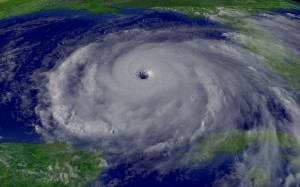
Hurricane
Rita, an intense Atlantic hurricane that hit the U.S. Gulf Coast in
September 2005. A new study finds most hurricanes over the Atlantic that
eventually make landfall in North America start as intense
thunderstorms in western Africa.
Credit: NOAA
Credit: NOAA
By Tallie Lieberman-Levy (Posted by nbompey)
Hurricanes
require moisture, the rotation of the Earth, and warm ocean temperatures
to grow from mere atmospheric disturbances into tropical storms. But
where do these storm cells originate, and exactly what makes an
atmospheric disturbance amp up full throttle?
A new study accepted for publication in Geophysical Research Letters finds
most hurricanes over the Atlantic Ocean that eventually make landfall
in North America actually start as intense thunderstorms in western
Africa.
“Eighty-five
percent of the most intense hurricanes affecting the U.S. and Canada
start off as disturbances in the atmosphere over western Africa,” said
Colin Price, a Professor in Atmospheric Sciences in the Department of
Geosciences at Tel Aviv University in Israel, and lead author of the new
paper. “We found that the larger the area covered by the disturbances,
the higher the chance they would develop into hurricanes only one to two
weeks later.”
Watching the clouds gather
Using data
covering 2005-2010, Price analyzed images of cloud cover taken by
geostationary satellites, which orbit the Earth at the precise speed of
the Earth’s rotation and take pictures of cloud cover every 15 minutes.
This enabled Price to track the variability in cloud cover blocking the
Earth’s surface in West Africa between the months of June and November —
hurricane season.
The coverage of
clouds acts as an indication of atmospheric disturbances. The more
clouds in an area, the larger the disturbance. Using infrared cloud-top
temperature data gathered from satellites, Price assessed the
temperatures of the cloud tops, which grow colder the higher they rise.
He then compared his cloud data with hurricane statistics — intensity,
date of generation, location, and maximum winds — from the same period
using the National Hurricane Center database.
“We first
showed that the areal coverage of the cold cloud tops in tropical Africa
was a good indicator of the monthly number of atmospheric disturbances —
or waves — leaving the west coast of tropical Africa,” said Price. “The
disturbances that developed into tropical storms had a significantly
larger area covered by cold cloud tops compared with non-developing
waves.”
What makes them special
According to
Price, only 10 percent of the 60 disturbances originating in Africa
every year turn into hurricanes. And while there are around 90
hurricanes globally every year, only 10 develop in the Atlantic Ocean.
“We wanted to
know what was so special about these 10 percent of disturbances that
develop into hurricanes. Was there something different about these
storms at their genesis?” said Price. “By looking at each of these
storms individually, we found again that the larger the cloud coverage
originally in West Africa, the higher the value of the accumulated
cyclone energy in a future hurricane. The conclusion, then, is that the
spatial coverage of thunderstorms in West Africa can foretell the
intensity of a hurricane a week later.”
“If we can
predict a hurricane one or two weeks in advance — the entire lifespan of
a hurricane — imagine how much better prepared cities and towns can be
to meet these phenomena head on,” Price said. He is currently examining
the thunderstorm clusters around the eyes of hurricanes to study the
intensification process of those destructive phenomena.
– Tallie Lieberman-Levy works at Tel Aviv University. This post originally appeared on the American Friends of Tel Aviv University website.
Nenhum comentário:
Postar um comentário